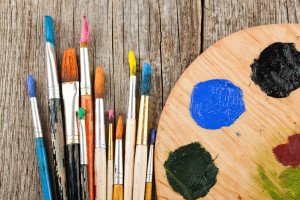- Calls to this hotline are currently being directed to Within Health, Fay or Eating Disorder Solutions
- Representatives are standing by 24/7 to help answer your questions
- All calls are confidential and HIPAA compliant
- There is no obligation or cost to call
- Eating Disorder Hope does not receive any commissions or fees dependent upon which provider you select
- Additional treatment providers are located on our directory or samhsa.gov
Art Therapy for ED Sufferers Recovering from Trauma
Contributed By: Rebecca Cooper, LMFT, LPCC, CEDS, Author, Founder, Rebecca’s House Eating Disorder Treatment Programs
 People with eating disorders often struggle with identifying feelings. In fact, the eating disorder it often an attempt to suppress feelings of rage, depression, anxiety, loss, and powerlessness.
People with eating disorders often struggle with identifying feelings. In fact, the eating disorder it often an attempt to suppress feelings of rage, depression, anxiety, loss, and powerlessness.
Art therapy allows these feelings to safely emerge on the paper while providing new insights and awareness. Art therapy provides freedom of expression and promotes self-efficacy.
An Important Part of Therapy
The creative arts therapies are an important part of medicine for psychological and physiological illnesses. The National Center of Complementary and Alternative Medicine of the National Institutes of Health recognizes three arts therapies: art, dance and music therapy.
They are developed from the theories of Freud and Jung, which led to a better understanding of one’s personality that are directly linked to the genesis of certain mental illness.1
The role of art therapy has been researched in many different areas. The studies showed that through art therapies patients improved their attention, concentration and memory.2 People with eating disorders have deficits in these areas due to the brain not getting the required nutrition while active in an eating disorder.
Where Art Therapy Can Be Used
Art therapy has also been used for:
- Trauma
- Depression
- Bereavement
- Pain management
- Sexual abuse
- Chronic fatigue immune dysfunction syndrome3
Through a persons’ artwork we can clearly observe the anger, confusion, depression, anxiety and guilt. Art therapy allows a person with an eating disorder to express feelings and explore the conflicts nonverbally. Talking about the pictures distance them enough to talk about the feelings. Drawing reduces high blood pressure and lessons tensions.
The Unconscious Elements of Art Therapy
 In the book, Art Therapy and Anorexia (1994), one author, Paola Luzzatto, describes how some patients are surprised as to the unconscious elements that emerge during art therapy. Even more unconscious elements emerged during silence.
In the book, Art Therapy and Anorexia (1994), one author, Paola Luzzatto, describes how some patients are surprised as to the unconscious elements that emerge during art therapy. Even more unconscious elements emerged during silence.
The art therapy allows the patient to separate from the image and then can use words to describe the picture. When the patient talks about the image it becomes part of the shared time and space instead of a secret. In this way the perspective has changed and they are no longer alone with the image.
Paola Luzzatto states that there is a recurrent theme especially among anorexic patients. There is a mental image in mind of the anorexic patient where they feel vulnerable and imprisoned and cannot ask for help. There is a persecutor out there and there is no reliable help around them. The awareness of this mental image helps the patient and therapist to get to the meaningless behaviors and the underlying pain.4
Dance as a Therapy
Dance therapy uses movement as a way to re-integrate individuals who suffered different traumas. The Handbook of Inquiry in the Arts Therapies: one river, many currents (1993) reviews the relationship between dance as a therapy for different disorders including:
- Anxiety
- Eating disorders
- Mood disorders
- Neuroses
- Personality disorders
- Somatic disorders, etc.
It can help in several psychological diseases such as deficits of self, depression and anxiety. Dance therapy is perfect for problems related to eating disorders because it explores a person’s tension and relaxation through movement. It enhances self-awareness of one’s emotions and sensations of hunger.5
Restoring the Dialog Between the Mind and Body
 Movement helps patients restore the dialog between the mind and the body and recreate the balance between them. Movement can help people with eating disorders clarify their body image.6
Movement helps patients restore the dialog between the mind and the body and recreate the balance between them. Movement can help people with eating disorders clarify their body image.6
Dance therapy has been used for people with eating disorders as a way to deal with shame, trauma, guilt and low self-esteem.
Music therapy has been shown to help patients with Attention Deficit Disorder and patients treated with instrumental music by Mozart showed reduced impulsivity and targeted behaviors.7 The impulsivity of the eating disorder behaviors are well known.
Music for Stress & Anxiety Reduction
Snyder and Chlan’s article in the Annual Review of Nursing Research provides 98 references to music therapy and patient stress reduction.8 It has been showed that music reduces stress and anxiety.9 Using music therapy can teach the person to use music instead of the eating disorder to reduce stress and enhance relaxation.
The art therapies can be instrumental in the treatment of eating disorders. It is important that the therapist has been trained in art therapy in order to provide the best therapeutic outcome.
Community Discussion – Share your thoughts here!
What has been your experience with art therapy? How has it impacted your recovery?
References:
- Rubin JA. Art therapy: an introduction. London: Taylor & Francis; 1998.
- David IR, An exploration of the role of art as therapy in rehabilitation from traumatic brain injury. Dissertation Abstracts International: Section B: The Sciences and Engineering 2000;60(8-B):3894
- Edwards GM. Art therapy with HIV-positive patients: hardiness, creativity, and meaning. Arts in Psychotherapy 1993;20(4):325–33
- Board, F. Art Therapies and Clients with Eating Disorders 1994; 60-74
- DuBose LR. Dance/movement treatment perspectives. In: Robert-McComb JJ, editor.Eating disorders in women and children: prevention, stress management, and treatment. Boca-Raton (FL): CRC Press; 2001. p. 373–85.
- De Tommasi V. Dance-movement-therapy (DMT) and eating disorders: a possible methodof approach. Methods of Research & Clinical Experience
- Pratt RR, Abel H-H, Skidmore J. The effects of neurofeedback with background music on EEG patterns of ADD and ADHD children. International Journal of Arts Medicine 1995;4(1):24–31
- Synder M, Chlan L. Music therapy. Annu Rev Nurs Res 1999;17:3–25.
- Thaut MH, Brown SH, Benjamin J, in et al. Rhythmic facilitation of movement sequencing:Effects on spatiotemporal control and sensory modality dependence.
The opinions and views of our guest contributors are shared to provide a broad perspective of eating disorders. These are not necessarily the views of Eating Disorder Hope, but an effort to offer discussion of various issues by different concerned individuals.
Last Updated & Reviewed By: Jacquelyn Ekern, MS, LPC on March 27th, 2015
Published on EatingDisorderHope.com

